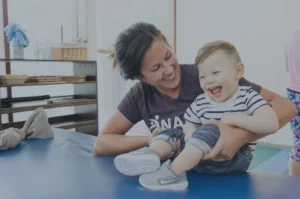Did you know that pediatric physical therapy is one of the most important aspects of a child’s development? Many children struggle with developmental delays, which can be corrected with the help of a physical therapist. In this blog post, we will discuss the benefits of pediatric physical therapy and provide you with some things you need to know about it!
Contents
What Is Pediatric Physical Therapy?
 Pediatric physical therapy is described as a form of therapy that is focused on improving the overall physical health and development of children. It includes activities that are designed to help improve gross and fine motor skills, posture, balance, flexibility, strength, and endurance.
Pediatric physical therapy is described as a form of therapy that is focused on improving the overall physical health and development of children. It includes activities that are designed to help improve gross and fine motor skills, posture, balance, flexibility, strength, and endurance.
This type of physical therapy is important in helping children with various things to reach their full potential. In several studies, it has been shown that physical therapy can improve their quality of life and help them in achieving their goals. So, if you are a parent, it would be wise to consider pediatric physical therapy for your child.
How Does It Work?
Pediatric physical therapy works through various techniques that focus on improving the physical abilities and abilities of children with physical disabilities. Physical therapists will work with families to create a plan that best meets the individual needs of each child. Treatment methods may include:
Range-of-motion exercises
It is intended to help improve or maintain the range of motion in joints and muscles that could be affected by a physical disability. These types of exercises may include stretching and strengthening certain parts of the body.
Gait training
This type of therapy helps children learn how to walk with proper posture and balance, as well as helps them with coordination. It can also focus on other aspects of mobility such as crawling, sitting, running, jumping, and climbing.
Strength training
Physical therapists use strength training exercises to help build and maintain muscle strength. These exercises are tailored to the individual needs of each child and may involve the use of exercise equipment such as weights, resistive bands, and balance balls.
Balance training
This type of treatment focuses on improving a child’s ability to maintain balance. It can include activities that require coordination as well as exercises to help build strength and stability. For example, balance balls are often used in this type of therapy.
Aquatic Therapy
This type of physical therapy is done in a pool setting and is beneficial for children who need help with mobility or balance. The warm water can help relax muscles, making it easier to move around and perform exercises. In fact, water has been found to reduce the effects of gravity on the body, making it easier for children with limited mobility to move around.
Overall, pediatric physical therapy can be a great tool for helping children improve their physical abilities and functioning. It is important to work with a qualified physical therapist who understands your child’s needs and can create a plan that will work best for them.
It is also important to remember that this type of therapy requires consistency and dedication in order to see the best results. With dedication and consistency, pediatric physical therapy can be a great way to help your child reach their fullest potential.
What Conditions It Can Treat?
 There are many conditions that can be treated with pediatric physical therapy. These include:
There are many conditions that can be treated with pediatric physical therapy. These include:
- Developmental delays: It can help children with developmental delays by addressing their motor, cognitive and physical needs.
- Muscular dystrophy: It can be used to improve muscle strength and coordination in children with muscular dystrophy.
- Cerebral palsy: Physical therapy can help a child with cerebral palsy learn how to move more efficiently and effectively.
- Down syndrome: This condition is associated with developmental delays, and physical therapy can help improve balance and coordination.
- Spina bifida: Physical therapy can be used to strengthen muscles and promote mobility in children with spina bifida.
- Autism: Physical therapists can provide sensory integration to help kids with autism better interact with their environment.
In addition to these conditions, physical therapy can also help with:
- Sports injuries: These are common with children and physical therapy can help improve mobility and reduce pain.
- Post-operative care: Physical therapists can help with post-operative rehabilitation to ensure optimal recovery.
- Injury prevention: Through strengthening muscles and proper body mechanics, physical therapy can help prevent future injuries.
- Postural dysfunction: This is a condition in children where their posture is misaligned or off-balance. Physical therapy can help improve this issue.
- Coordination problems: Finally physical therapy can be used to improve coordination and motor control in children.
Overall, pediatric physical therapy is an important tool for helping children with a variety of conditions. With its help, they can learn how to move properly, reduce pain and prevent injuries. Physical therapists offer specialized care tailored to the needs of each individual child so that they can experience healthier and more productive lives.
How Is Pediatric Physical Therapy Different From Regular PT?
While physical therapy is beneficial for people of all ages, pediatric physical therapy takes a more specialized approach. Pediatric physical therapists are specially trained to work with children and understand the unique motor development that happens during early childhood. They also focus on helping children grow their confidence and build independence while they learn how to move safely and effectively.
So, the main difference between pediatric physical therapy and regular physical therapy is the focus on the child’s unique needs and development. Pediatric physical therapists understand how to use play-based activities and games to help children learn how to move properly, whereas regular physical therapy is more focused on adults and their mobility needs.
Benefits Of Pediatric Physical Therapy
 There are several benefits of pediatric physical therapy that can help in the overall development of a child. Some of these benefits include:
There are several benefits of pediatric physical therapy that can help in the overall development of a child. Some of these benefits include:
- Improved motor skills – Through physical therapy, children can develop improved gross and fine motor skills. This can enable them to perform everyday tasks such as walking, running, and climbing with greater ease and efficiency.
- Improved coordination – Physical therapy also helps to improve coordination in children. Through activities like balance exercises, children can become more coordinated while performing daily tasks or playing sports.
- Improved strength – Pediatric physical therapists can help children build strength in their muscles and tendons. This can help them with activities such as playing on the playground, lifting objects, or even getting out of bed.
- Improved posture – Regular physical therapy sessions can also help improve a child’s posture. Proper alignment will reduce the risk of injuries due to improper body positioning.
- Improved flexibility – Pediatric physical therapy can also help to improve a child’s range of motion and flexibility. This will make it easier for them to perform everyday activities without any discomfort or pain.
- Improved endurance – Finally, pediatric physical therapy will also help children build their stamina and endurance. Regular sessions can help them become more active and fit overall, allowing them to participate in activities with greater ease.
These are just some of the many benefits that pediatric physical therapy can provide for children. With regular sessions, children can develop improved gross and fine motor skills, coordination, strength, posture, flexibility, and endurance. All these improvements will have a positive effect on their overall physical health and development.
Where Can You Find Pediatric Physical Therapy?
This might be the first question that comes to mind when considering pediatric physical therapy. Pediatric physical therapists can be found in a variety of settings, including:
- Private practices
- Hospitals
- Medical clinics
- Homecare and schools
These are the most common settings where parents can find pediatric physical therapists. Depending on the location of the therapy, parents can look for a therapist that is certified and experienced in providing detailed care to children with special needs.
Be sure to ask about the therapist’s experience in working with children and ask if they have any special certifications, such as pediatric specialization. With the right research and time, you can find the best physical therapist for your child’s needs.
Conclusion
To conclude, pediatric physical therapy is considered to be an important part of overall healthcare for children. It can help reduce pain, improve mobility and strength, and increase independence. When considering whether or not to pursue pediatric physical therapy for your child, it’s important to speak with a qualified professional about any potential benefits and risks that may be associated with the treatment.
It’s also essential to ensure that any therapist you work with is a certified pediatric physical therapist and to create an individualized treatment plan for your child’s needs. With the right care, pediatric physical therapy can be a highly effective way of improving your child’s quality of life.
Physical Therapy has always been proven to help patients recover from pain. Hence, if you’re experiencing Back pain, Shoulder pain, Knee pain, Neck pain, Elbow pain, Hip pain, or Arthritis pain, a physical therapist at MantraCare can help: Book a physiotherapy session.


